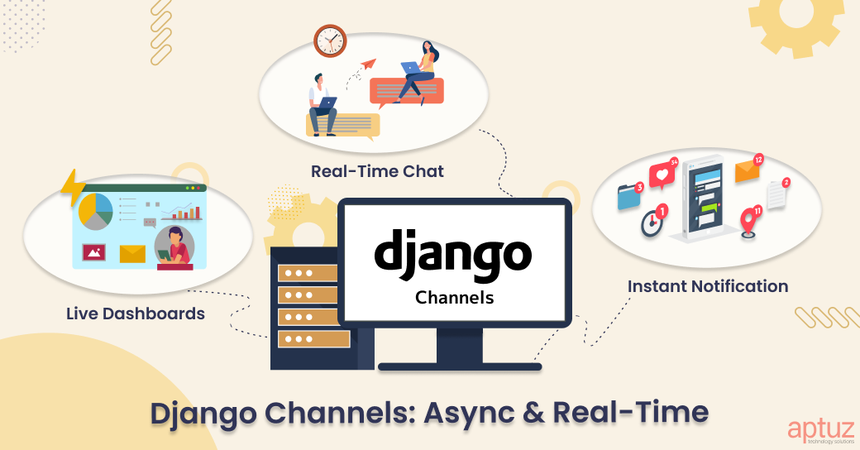Ever wanted to build a real-time chat app or live dashboard with Django? Traditional Django is synchronous and great for HTTP, but it falls short when you need real-time, event-driven functionality. That’s where Django Channels come in—bringing async power to Django and making WebSocket support a breeze.
In this post, we’ll cover:
- What Django Channels are and why they matter
- The key components: ASGI, Consumers, Routing, Channel Layers
- How to set up Django Channels with WebSocket's (with code)
- A high-level overview of how everything works together
What Are Django Channels?
Django Channels extend the traditional Django request-response cycle by adding asynchronous capabilities. This allows Django to handle:
- WebSockets
- Background tasks
- Other event-driven protocols
In short, Django Channels unlock real-time functionality—from chat apps to live notifications and dashboards.
Traditional Django Architecture
Browser (HTTP Request)
--> WSGI Server (Django Backend Views)
--> Browser (Response)
This model uses WSGI (Web Server Gateway Interface), which is synchronous. Each request is processed one at a time per worker, and the connection closes immediately after sending the response.
Django Channels Architecture
Client (HTTP/WebSocket/Event)
--> Channel Layer
--> Consumers (Async Logic)
--> Response/Event Trigger
--> Client
With Django Channels, connections—especially WebSocket's—stay open, allowing the server to push updates in real-time. Django Channels run on ASGI (Asynchronous Server Gateway Interface), enabling async/await and non-blocking, long-lived connections.
Installation
Install Django Channels via pip:
pip install channels
Key Components of Django Channels
1. ASGI
ASGI is the modern replacement for WSGI, enabling Django to handle HTTP, WebSocket's, and more—all asynchronously.
2. Consumers
Think of consumers like Django views—but for async protocols like WebSocket's. They handle:
- connect(): When a user connects
- receive(): When a message is received
- disconnect(): When the connection is closed
3. Routing
Similar to Django’s urls.py, routing in Django Channels maps WebSocket URLs to consumers.
4. Channel Layer
A messaging system (often backed by Redis) that allows consumers to:
- Broadcast messages to groups
- Send events between parts of your app
Example: In a chat app, everyone in a room (group) gets real-time updates.
5. Middleware Stack
Django Channels uses a middleware stack to manage different types of connections.
- ProtocolTypeRouter: Directs HTTP, WebSocket, etc.
- AuthMiddlewareStack: Adds Django session-based authentication for WebSockets.
Configuring Django Channels (With Code)
ASGI Setup
settings.py
ASGI_APPLICATION = 'your_app.asgi.application'
asgi.py
import os
from django.core.asgi import get_asgi_application
from channels.routing import ProtocolTypeRouter, URLRouter
from channels.auth import AuthMiddlewareStack
import chat.routing
os.environ.setdefault('DJANGO_SETTINGS_MODULE', 'mywebsite.settings')
application = ProtocolTypeRouter({
"http": get_asgi_application(),
"websocket": AuthMiddlewareStack(
URLRouter(chat.routing.websocket_urlpatterns)
)
})
Consumer Example
consumers.py
from channels.generic.websocket import AsyncWebsocketConsumer
import json
class ChatConsumer(AsyncWebsocketConsumer):
async def connect(self):
self.room_group_name = 'test'
await self.channel_layer.group_add(self.room_group_name, self.channel_name)
await self.accept()
await self.send(text_data=json.dumps({
'message': 'You are connected to the chat server!',
'type': 'connection_established',
}))
async def receive(self, text_data):
data = json.loads(text_data)
message = data['message']
await self.channel_layer.group_send(
self.room_group_name,
{
'type': 'chat_message',
'message': message,
}
)
async def chat_message(self, event):
message = event['message']
await self.send(text_data=json.dumps({
'message': message,
'type': 'chat_message',
}))
async def disconnect(self, close_code):
await self.channel_layer.group_discard(self.room_group_name, self.channel_name)
Routing
routing.py
from django.urls import re_path
from . import consumers
websocket_urlpatterns = [
re_path(r'ws/socket-server/', consumers.ChatConsumer.as_asgi()),
]
Channel Layer
settings.py (for development)
CHANNEL_LAYERS = {
'default': {
'BACKEND': 'channels.layers.InMemoryChannelLayer',
},
}
For production (using Redis):
CHANNEL_LAYERS = {
'default': {
'BACKEND': 'channels_redis.core.RedisChannelLayer',
'CONFIG': {
'hosts': [('localhost', 6379)],
},
},
}
How Django Channels Work (Behind the Scenes)
ASGI_APPLICATION in settings.py points to your ASGI setup.
HTTP Requests: Routed through get_asgi_application(), behaving like classic Django.
WebSocket Connections: Routed via:
- ProtocolTypeRouter ➔ AuthMiddlewareStack ➔ URLRouter ➔ your Consumer
Consumer Logic: Handles real-time WebSocket events (connect, receive, disconnect).
Why Django Channels Matter
Django Channels lets you build real-time, event-driven apps—without abandoning Django’s ecosystem. Whether it’s:
- Chat systems
- Live dashboards
- Notification engines
…Channels open the door to modern, async functionality inside Django.
Final Takeaway
Django Channels transforms Django from a traditional HTTP-only framework into a powerful event-driven system. By integrating WebSocket's and async programming, you can build modern apps that stay responsive, scalable, and real-time ready.

